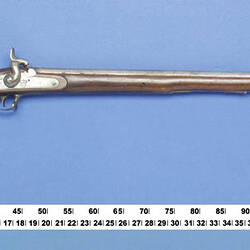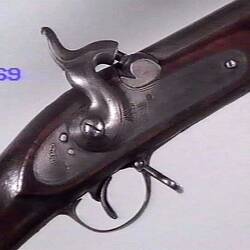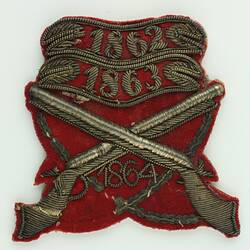Summary
British Service percussion musket, Pattern 1842 Musket (Sea Service), cal. .665 in., steel smoothbore round barrel, 771 mm long, no bayonet catch on R.H.side.
One of 26 guns donated in 1871 by the Victorian Ordnance Department from its Melbourne Armoury, for the newly created Industrial and Technological Museum. The display was intended to show mechanics and gunsmiths the principles of gun construction and recent technical developments in weapons.
Physical Description
Steel side lock and hammer on R.H. side, brass oval triggerguard with small acorn front spur and longer rear extension, two brass 'Lovell's sidenail cups' for lockplate screws on L.H.side, brass foreend and butt plate, two sling swivels, one mounted from triggerguard, the other above front ramrod tube. Block foresight, no rear sight, barrel fastened to stock via two barrel pins, steel ramrod, and three brass ramrod tubes, the front one being trumpet shaped. Lockplate removed for inspection and one small mark noted appearing perhaps as 'WR'. Barrel L.H.side stamped with two Birmingham proof marks and between the same mark - WR - as appears on inside of lock face.
Significance
While at first glance it appears to be a Pattern 1842 Sea Service Musket, due to its approx. 30" barrel length and smoothbore, its calibre of .665 is not the norm for this model, nor are the fittings: the acorn extension to the triggerguard, three ramrod tubes on the shortened barrel model, the lack of a bayonet catch, lack of rear sight, and the overall size of the model which is tighter, and lighter, than a genuine Altered Pattern 1842 model. It is possible that example has been produced under contract, denoted by the markings to the barrel and lock inner face, though why the calibre is so markedly different remains unexplained. It has obviously been produced and stocked in England, as illustrated by the Board of Ordnance markings to the stock.
More Information
-
Collecting Areas
-
Acquisition Information
Donation from Melbourne Armoury, 24 Oct 1871
-
User
Victoria: Ordnance Branch, Melbourne, Greater Melbourne, Victoria, Australia, 1840s-1860s
-
Inscriptions
Stamped on lockplate: TOWER, crown Stamped on stock R.H.side: broad arrow over 'B', government broad arrow, 'O'/ 'D' Stamped on barrel with Birmingham government proofmarks Stamped on barrel with unidentified mark: WR (?) Stamped on lockplate inside with unidentified mark: WR (?)
-
Model Name or Number
-
Brand Names
-
Classification
-
Category
-
Discipline
-
Type of item
-
Overall Dimensions
116.5 cm (Length), 6 cm (Width), 18.5 cm (Height)
Barrel length: 77.10cm
-
References
[Book] Penrose, Edgar H. 1949. Descriptive Catalogue of the Collection of Firearms in the Museum of Applied Science of Victoria. 161. 14.
-
Keywords
Rifles & Muskets: British, Rifles & Muskets: Military, Victorian Colonial Defence Forces




